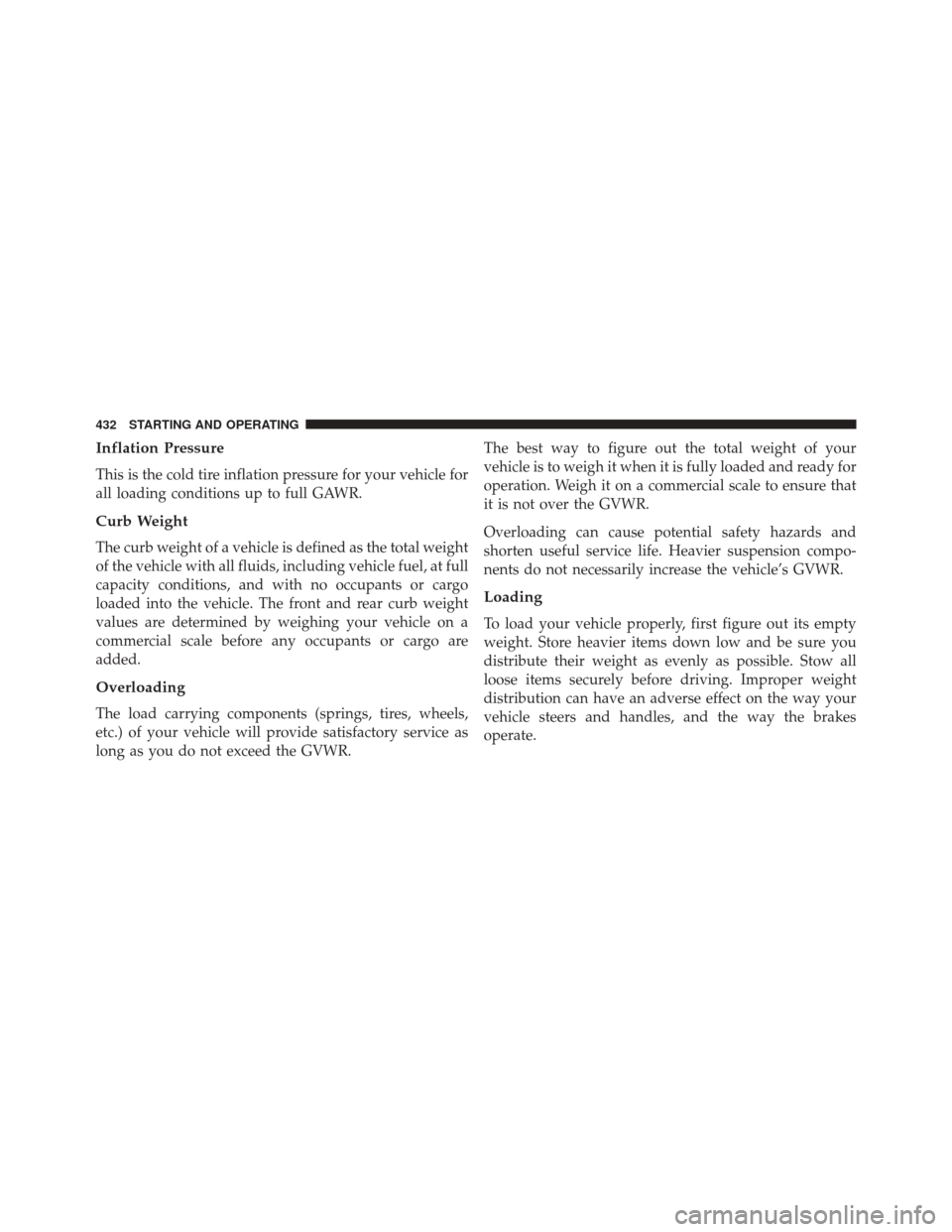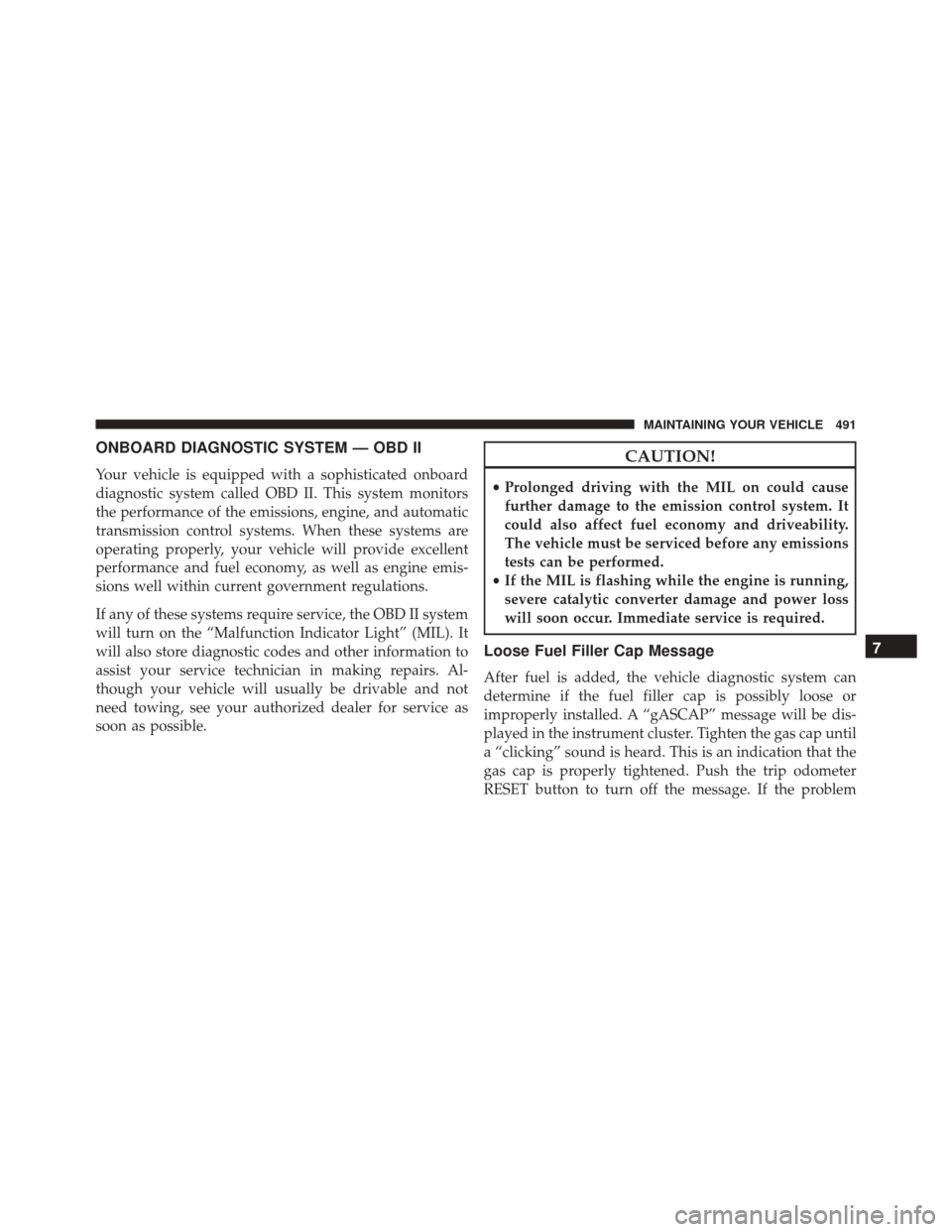Page 434 of 587

Inflation Pressure
This is the cold tire inflation pressure for your vehicle for
all loading conditions up to full GAWR.
Curb Weight
The curb weight of a vehicle is defined as the total weight
of the vehicle with all fluids, including vehicle fuel, at full
capacity conditions, and with no occupants or cargo
loaded into the vehicle. The front and rear curb weight
values are determined by weighing your vehicle on a
commercial scale before any occupants or cargo are
added.
Overloading
The load carrying components (springs, tires, wheels,
etc.) of your vehicle will provide satisfactory service as
long as you do not exceed the GVWR.The best way to figure out the total weight of your
vehicle is to weigh it when it is fully loaded and ready for
operation. Weigh it on a commercial scale to ensure that
it is not over the GVWR.
Overloading can cause potential safety hazards and
shorten useful service life. Heavier suspension compo-
nents do not necessarily increase the vehicle’s GVWR.
Loading
To load your vehicle properly, first figure out its empty
weight. Store heavier items down low and be sure you
distribute their weight as evenly as possible. Stow all
loose items securely before driving. Improper weight
distribution can have an adverse effect on the way your
vehicle steers and handles, and the way the brakes
operate.
432 STARTING AND OPERATING
Page 489 of 587
MAINTAINING YOUR VEHICLE
CONTENTS
�ENGINE COMPARTMENT — 2.0L ..........489
� ENGINE COMPARTMENT — 2.4L ..........490
� ONBOARD DIAGNOSTIC SYSTEM — OBD II . .491
▫ Loose Fuel Filler Cap Message ............491
� EMISSIONS INSPECTION AND MAINTENANCE
PROGRAMS ......................... .492
� REPLACEMENT PARTS ..................493
� DEALER SERVICE ..................... .494
� MAINTENANCE PROCEDURES ...........494
▫ Engine Oil ......................... .495▫
Engine Oil Filter ..................... .498
▫ Engine Air Cleaner Filter ................499
▫ Maintenance-Free Battery ...............499
▫ Air Conditioner Maintenance .............501
▫ Body Lubrication .....................503
▫ Windshield Wiper Blades ...............504
▫ Adding Washer Fluid ..................504
▫ Exhaust System ..................... .505
▫ Cooling System ..................... .507
▫ Brake System ....................... .513
7
Page 493 of 587

ONBOARD DIAGNOSTIC SYSTEM — OBD II
Your vehicle is equipped with a sophisticated onboard
diagnostic system called OBD II. This system monitors
the performance of the emissions, engine, and automatic
transmission control systems. When these systems are
operating properly, your vehicle will provide excellent
performance and fuel economy, as well as engine emis-
sions well within current government regulations.
If any of these systems require service, the OBD II system
will turn on the “Malfunction Indicator Light” (MIL). It
will also store diagnostic codes and other information to
assist your service technician in making repairs. Al-
though your vehicle will usually be drivable and not
need towing, see your authorized dealer for service as
soon as possible.
CAUTION!
•Prolonged driving with the MIL on could cause
further damage to the emission control system. It
could also affect fuel economy and driveability.
The vehicle must be serviced before any emissions
tests can be performed.
• If the MIL is flashing while the engine is running,
severe catalytic converter damage and power loss
will soon occur. Immediate service is required.
Loose Fuel Filler Cap Message
After fuel is added, the vehicle diagnostic system can
determine if the fuel filler cap is possibly loose or
improperly installed. A “gASCAP” message will be dis-
played in the instrument cluster. Tighten the gas cap until
a “clicking” sound is heard. This is an indication that the
gas cap is properly tightened. Push the trip odometer
RESET button to turn off the message. If the problem
7
MAINTAINING YOUR VEHICLE 491
Page 499 of 587

American Petroleum Institute (API) Engine Oil
Identification Symbol
This symbol means that the oil has
been certified by the American
Petroleum Institute (API). The
manufacturer only recommends
API Certified engine oils.
This symbol certifies 0W-20, 5W-
20, 0W-30, 5W-30 and 10W-30 en-
gine oils.
CAUTION!
Do not use chemical flushes in your engine oil as the
chemicals can damage your engine. Such damage is
not covered by the New Vehicle Limited Warranty.
Engine Oil Viscosity (SAE Grade) — 2.0L, 2.4L
Engine
MOPAR SAE 5W-20 engine oil approved to FCA US
Material Standard MS-6395 such as Pennzoil, Shell Helix
or equivalent is recommended for all operating tempera-
tures. This engine oil improves low temperature starting
and vehicle fuel economy.
The engine oil filler cap also shows the recommended
engine oil viscosity for your engine. For information on
engine oil filler cap location, refer to “Engine Compart-
ment” in this section.
Lubricants which do not have both the engine oil certi-
fication mark and the correct SAE viscosity grade num-
ber should not be used.
7
MAINTAINING YOUR VEHICLE 497
Page 539 of 587
License Lamps
1. Use a screw driver to gently pry against the side of thesnap tab to remove the lamp from the liftgate.
2. Rotate the socket 1/4 turn counterclockwise.
3. Pull the bulb from the socket.
Center High-Mounted Stoplamp
This light is an LED assembly. See your authorized dealer
for replacement.
FLUID CAPACITIES
U.S. Metric
Fuel (Approximate) 13.6 Gallons51 Liters
Engine Oil with Filter
2.0L and 2.4L Engine (SAE 5W-20, API Certified) 4.5 Quarts4.26 Liters
Cooling System *
2.0L and 2.4L Engine (MOPAR Antifreeze/Engine
Coolant 10 Year/150,000 Mile Formula or equivalent) 7.2 Quarts
6.8 Liters
* Includes heater and coolant recovery bottle filled to MAX level.
7
MAINTAINING YOUR VEHICLE 537
Page 540 of 587
FLUIDS, LUBRICANTS, AND GENUINE PARTS
Engine
ComponentFluid, Lubricant, or Genuine Part
Engine Coolant We recommend you use MOPAR Antifreeze/Coolant 10 Year/150,000 Mile
Formula OAT (Organic Additive Technology) or equivalent meeting the
requirements of FCA Material Standard MS.90032.
Engine Oil We recommend you use API Certified SAE 5W-20 Engine Oil, meeting the
requirements of FCA US Material Standard MS-6395 such as MOPAR,
Pennzoil, and Shell Helix. Refer to your engine oil filler cap for correct SAE
grade.
Engine Oil Filter We recommend you use MOPAR Engine Oil Filter or equivalent.
Spark Plugs We recommend you use MOPAR Spark Plugs.
Fuel Selection 87 Octane, 0-15% Ethanol.
538 MAINTAINING YOUR VEHICLE
Page 568 of 587

Bulbs, Light......................... .101, 534
Calibration, Compass ..................... .258
Camera, Rear ........................... .179
Capacities, Antifreeze (Engine Coolant) ..........537
Capacities, Fluid ......................... .537
Caps, Filler Fuel ................................ .428
Oil (Engine) ....................489, 490, 497
Power Steering ........................ .369
Radiator (Coolant Pressure) ................511
Carbon Monoxide Warning ................98, 428
Cargo Area Cover ........................ .203
Cargo Area Features ...................... .203
Cargo Compartment ...................... .203
Light ............................... .203
Luggage Carrier ....................... .210
Cargo Light ............................ .203
Cargo Load Floor ........................ .205Cargo Tie-Downs
........................ .206
Car Washes ............................ .522
Cellular Phone ...........................112
Center High Mounted Stop Light ..............537
Chains, Tire ............................ .412
Changing A Flat Tire ...................... .454
Chart, Tire Sizing ........................ .390
Check Engine Light (Malfunction Indicator Light) . .492
Checking Your Vehicle For Safety ...............97
Checks, Safety ............................97
Child Restraint ............................75
Child Restraints Booster Seats ...........................80
Child Restraints .........................75
Child Seat Installation .....................93
How To Stow An Unused ALR Seat Belt ........89
Infants And Child Restraints ................78
Install A LATCH-Compatible Child Restraint ....88
566 INDEX
Page 571 of 587

Emergency, In Case OfJacking .............................. .454
Jump Starting ......................... .475
Towing ............................. .482
Emission Control System Maintenance ..........492
Engine ............................. .489, 490
Air Cleaner .......................... .499
Block Heater ......................... .338
Break-In Recommendations .................96
Checking Oil Level ..................... .495
Coolant (Antifreeze) ..................507, 538
Cooling ............................. .507
Exhaust Gas Caution ..................98, 428
Fuel Requirements ..................... .424
Jump Starting ......................... .475
Oil .......................... .495, 537, 538
Oil Filler Cap ...................489, 490, 497
Oil Filter ............................ .498
Oil Selection .......................... .496Oil Synthetic
......................... .498
Overheating .......................... .451
Enhanced Accident Response Feature ............70
Ethanol ............................... .425
Event Data Recorder ........................74
Exhaust Gas Caution ....................98, 428
Exhaust System ....................... .98, 505
Exterior Lights .......................... .101
Filters Air Cleaner .......................... .499
Air Conditioning ....................328, 502
Engine Oil ........................ .498, 538
Engine Oil Disposal .....................498
Flashers ............................... .451
Hazard Warning ....................... .451
Turn Signal .....................101, 243, 536
Flooded Engine Starting ....................337
Fluid, Brake ............................ .540
10
INDEX 569